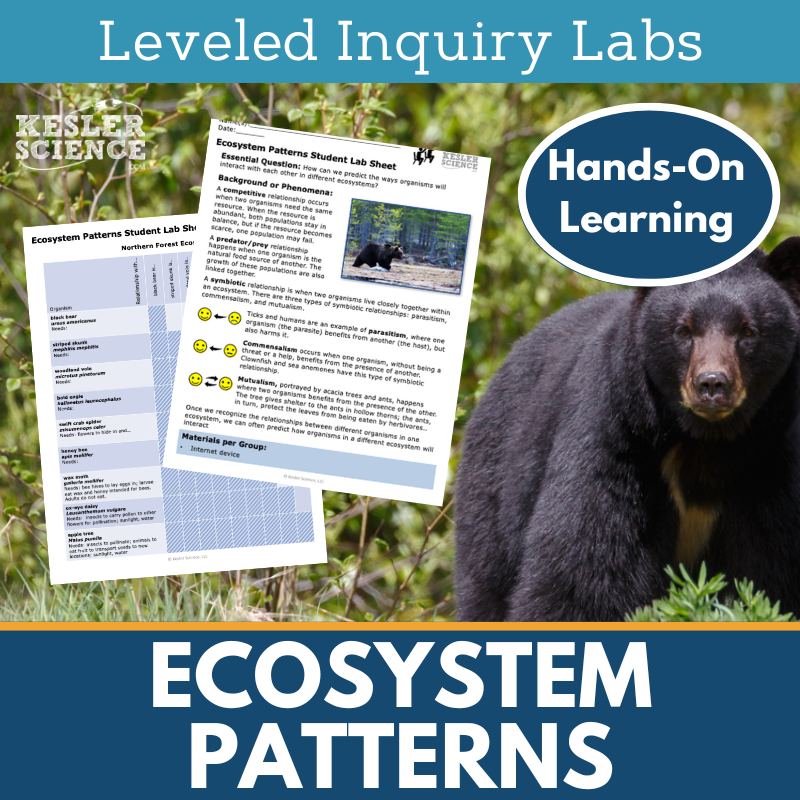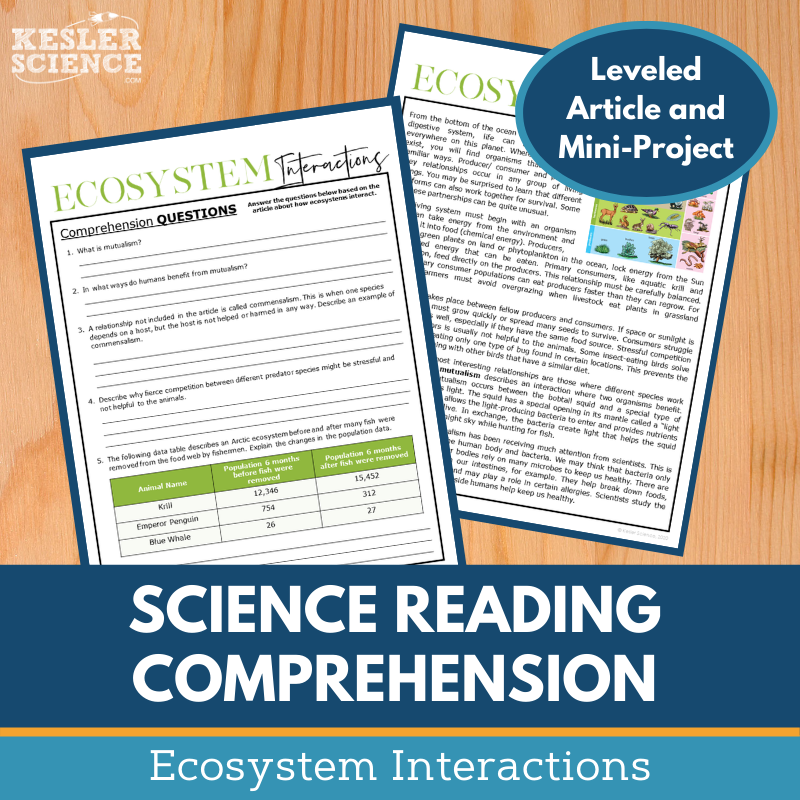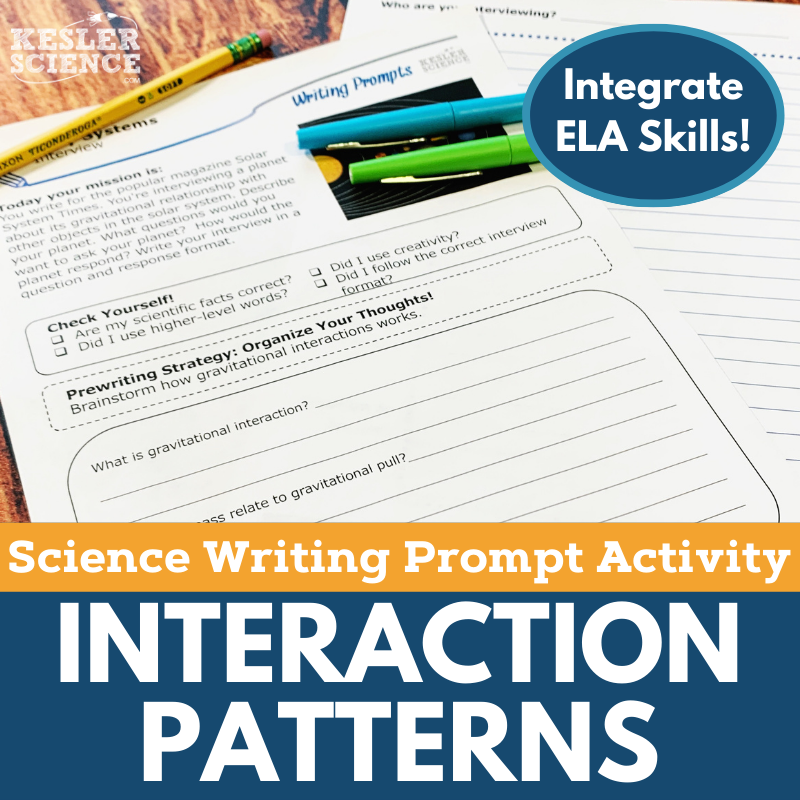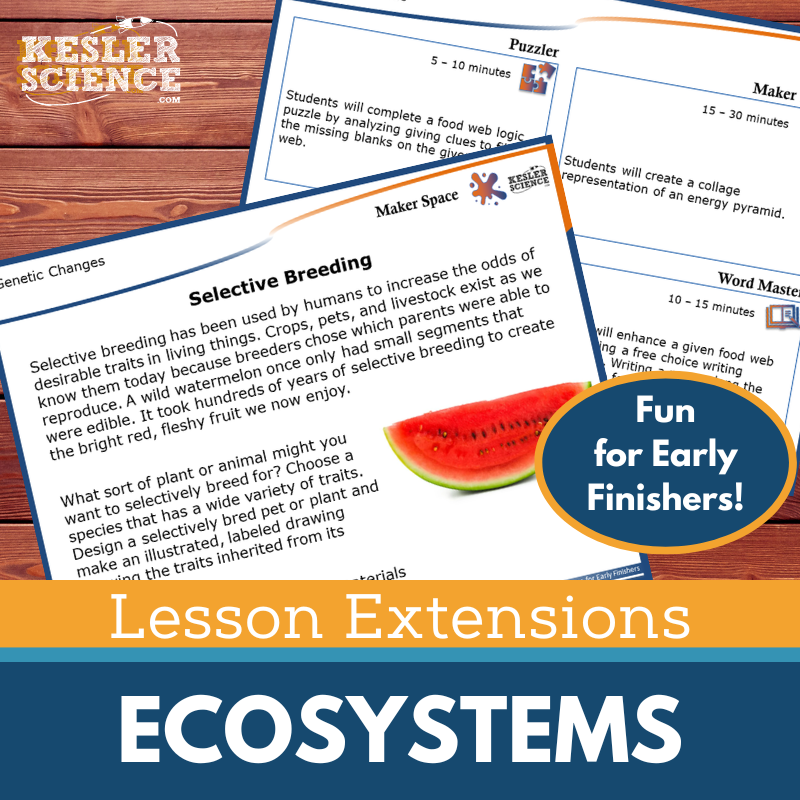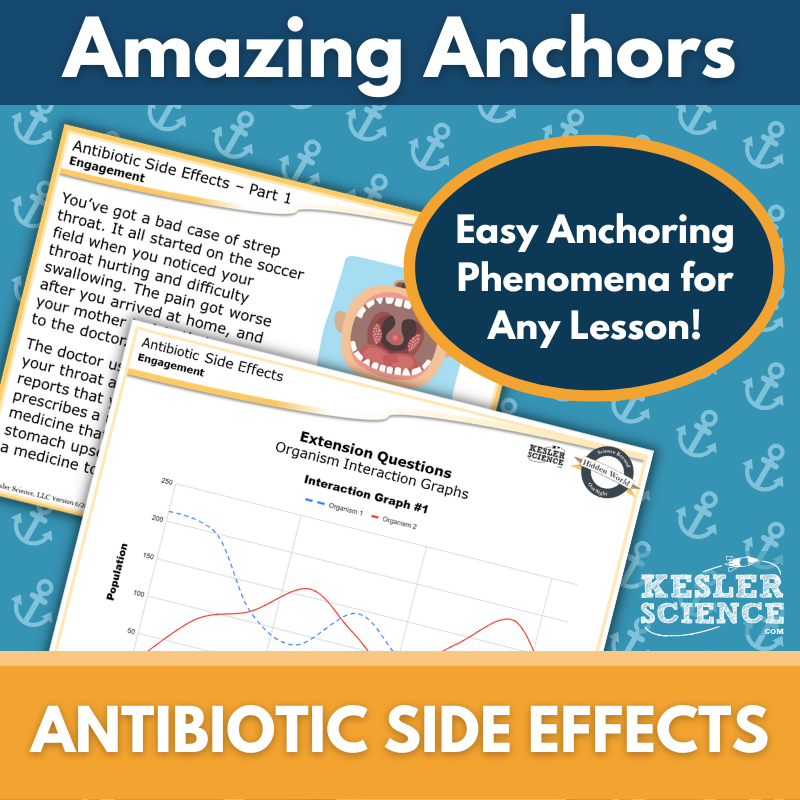Ecological Relationships Activities for Middle School Science
Explore predatory, competitive, and symbiotic relationships—mutualism, parasitism, and commensalism—with this engaging 5E lesson aligned to TEKS 6.12B. The resources below will give students a comprehensive understanding of ecological relationships. All of the following materials are also included in the Kesler Science Membership.
The Kesler Science Ecosystems 5E Lesson is a comprehensive unit for middle school students, focusing on predatory, competitive, and symbiotic relationships, including mutualism, parasitism, and commensalism. This editable, low-prep resource includes presentations, worksheets, student-choice projects, and assessments, supporting differentiated, student-led learning aligned with the 2021 TEKS 6.12B standard.
The lesson follows the 5E Model, beginning with engagement activities like vocabulary cards and class discussions. Exploration features a differentiated, student-led station lab with activities such as hands-on experiments, reading passages, research tasks, and videos. Students demonstrate understanding through categorization, writing, drawing, and formal assessments. Editable PowerPoints and interactive notebook templates in English and Spanish support the explanation phase. Elaboration allows students to extend their learning with choice projects on ecological relationships. Evaluation includes STAAR 2.0-aligned assessments and review worksheets. This versatile resource is designed for both in-class and virtual learning environments.
The Kesler Science Ecosystems 5E Lesson is a comprehensive unit for middle school students, focusing on predatory, competitive, and symbiotic relationships, including mutualism, parasitism, and commensalism. This editable, low-prep resource includes presentations, worksheets, student-choice projects, and assessments, supporting differentiated, student-led learning aligned with the 2021 TEKS 6.12B standard.
The lesson follows the 5E Model, beginning with engagement activities like vocabulary cards and class discussions. Exploration features a differentiated, student-led station lab with activities such as hands-on experiments, reading passages, research tasks, and videos. Students demonstrate understanding through categorization, writing, drawing, and formal assessments. Editable PowerPoints and interactive notebook templates in English and Spanish support the explanation phase. Elaboration allows students to extend their learning with choice projects on ecological relationships. Evaluation includes STAAR 2.0-aligned assessments and review worksheets. This versatile resource is designed for both in-class and virtual learning environments.
This student-led station lab, aligned with the 2021 TEKS 6.12B standard, engages middle school students in exploring ecological relationships. Throughout the lesson, students learn to describe and provide examples of predatory, competitive, and symbiotic interactions, including mutualism, parasitism, and commensalism. Designed for both in-class and virtual learning, this resource encourages students to take ownership of their learning through interactive, hands-on activities.
The lab features nine differentiated stations that allow students to work independently or in small groups. The Input Stations introduce new concepts through various methods: students participate in hands-on activities, watch short videos, read passages available in English and Spanish, and analyze facts, images, and graphs. The Output Stations help students demonstrate their understanding through organizing information, creating visual models, responding to written prompts, and completing assessments using task cards and vocabulary-based questions.
An additional Bonus Station - Challenge It! - offers extension activities such as crosswords, games, and mini-projects for early finishers or advanced learners. With minimal prep required, this versatile resource is ideal for both classroom and virtual learning environments, encouraging critical thinking, creativity, and student engagement.
This student-led station lab, aligned with the 2021 TEKS 6.12B standard, engages middle school students in exploring ecological relationships. Throughout the lesson, students learn to describe and provide examples of predatory, competitive, and symbiotic interactions, including mutualism, parasitism, and commensalism. Designed for both in-class and virtual learning, this resource encourages students to take ownership of their learning through interactive, hands-on activities.
The lab features nine differentiated stations that allow students to work independently or in small groups. The Input Stations introduce new concepts through various methods: students participate in hands-on activities, watch short videos, read passages available in English and Spanish, and analyze facts, images, and graphs. The Output Stations help students demonstrate their understanding through organizing information, creating visual models, responding to written prompts, and completing assessments using task cards and vocabulary-based questions.
An additional Bonus Station - Challenge It! - offers extension activities such as crosswords, games, and mini-projects for early finishers or advanced learners. With minimal prep required, this versatile resource is ideal for both classroom and virtual learning environments, encouraging critical thinking, creativity, and student engagement.
The Ecological Relationships Student Choice Projects align with the 2021 TEKS standard 6.12B, offering middle school students a variety of creative ways to demonstrate their understanding. The project page outlines six student-led options plus a “design your own” project, with an editable rubric for teacher, peer, or self-assessment. This resource is also included in the Ecological Relationships Complete Lesson for TEKS 6.12B.
These flexible, multimodal projects allow students to showcase their knowledge in personalized ways, and teachers can adjust the rubric to suit grading preferences. Two versions of the project page support differentiation, with modified options for students needing remediation and challenge opportunities for advanced learners.
The resource includes nine project choices, teacher directions for guidance, and editable rubrics assessing vocabulary, concepts, presentation, clarity, and accuracy. Projects can be completed using standard classroom supplies such as paper, markers, and scissors, with many options also available for digital completion.
The Ecological Relationships Student Choice Projects align with the 2021 TEKS standard 6.12B, offering middle school students a variety of creative ways to demonstrate their understanding. The project page outlines six student-led options plus a “design your own” project, with an editable rubric for teacher, peer, or self-assessment. This resource is also included in the Ecological Relationships Complete Lesson for TEKS 6.12B.
These flexible, multimodal projects allow students to showcase their knowledge in personalized ways, and teachers can adjust the rubric to suit grading preferences. Two versions of the project page support differentiation, with modified options for students needing remediation and challenge opportunities for advanced learners.
The resource includes nine project choices, teacher directions for guidance, and editable rubrics assessing vocabulary, concepts, presentation, clarity, and accuracy. Projects can be completed using standard classroom supplies such as paper, markers, and scissors, with many options also available for digital completion.
The Interactions in Ecosystems Inquiry Lab aligns with NGSS MS LS2-2, helping students explore interactions among organisms by researching a northern forest ecosystem and comparing it to another ecosystem to predict relationships. Key concepts include predator-prey dynamics, parasitism, commensalism, mutualism, consumers and producers, and competition within ecosystems.
This resource features three differentiated labs—structured, modified, and independent—catering to various learning needs. Teachers can customize editable pages, and CER (Claim, Evidence, Reasoning) conclusion questions with reflections guide students through critical thinking. Answer keys and teacher resource pages simplify preparation and grading.
Using standard classroom materials and an internet device, this engaging, hands-on lab fosters inquiry-based learning for all students.
The Interactions in Ecosystems Inquiry Lab aligns with NGSS MS LS2-2, helping students explore interactions among organisms by researching a northern forest ecosystem and comparing it to another ecosystem to predict relationships. Key concepts include predator-prey dynamics, parasitism, commensalism, mutualism, consumers and producers, and competition within ecosystems.
This resource features three differentiated labs—structured, modified, and independent—catering to various learning needs. Teachers can customize editable pages, and CER (Claim, Evidence, Reasoning) conclusion questions with reflections guide students through critical thinking. Answer keys and teacher resource pages simplify preparation and grading.
Using standard classroom materials and an internet device, this engaging, hands-on lab fosters inquiry-based learning for all students.
This science reading comprehension lesson helps students explore patterns of interactions among organisms in various ecosystems through a nonfiction article. Students answer comprehension questions and create an ecosystem profile highlighting organism interactions for survival.
Designed for grades 6–8 (and advanced 5th graders), the resource features two leveled articles with Lexile levels ranging from 1100–1300. Each article includes 5–7 comprehension questions, a hands-on mini-project, and a Cornell notes template. The materials feature engaging graphics, printable in grayscale.
This resource is suitable for in-person or virtual learning and is compatible with platforms like Google Classroom, MS Teams, Schoology, and Canvas. Students can complete assignments directly in the document using PowerPoint or Google Slides.
Ideal for absent students, ISS, extra credit, sub plans, or whole-class instruction, this lesson encourages classroom discussions and strengthens science literacy, reading comprehension, and textual analysis skills.
This science reading comprehension lesson helps students explore patterns of interactions among organisms in various ecosystems through a nonfiction article. Students answer comprehension questions and create an ecosystem profile highlighting organism interactions for survival.
Designed for grades 6–8 (and advanced 5th graders), the resource features two leveled articles with Lexile levels ranging from 1100–1300. Each article includes 5–7 comprehension questions, a hands-on mini-project, and a Cornell notes template. The materials feature engaging graphics, printable in grayscale.
This resource is suitable for in-person or virtual learning and is compatible with platforms like Google Classroom, MS Teams, Schoology, and Canvas. Students can complete assignments directly in the document using PowerPoint or Google Slides.
Ideal for absent students, ISS, extra credit, sub plans, or whole-class instruction, this lesson encourages classroom discussions and strengthens science literacy, reading comprehension, and textual analysis skills.
The Interaction Patterns Science Writing Prompt Activity engages middle school students in life science through creative journal entry exercises that encourage science reasoning and exploration. Designed for both in-person and virtual learning, this low-prep, student-centered resource helps reinforce understanding of interaction patterns among organisms across ecosystems, aligned with standard MS LS2-2.
This resource includes teacher directions with an answer guide, project ideas, and rubrics, along with projection-friendly prompts and printable handouts in both full and half-sheet formats for interactive notebooks. A digital version is also available in PowerPoint, compatible with Google Slides for remote or in-class assignments.
Ideal for cross-curricular activities, pre-test assessments, student choice projects, early finisher tasks, extra credit, make-up work, TELPAS samples, or differentiation exercises, this activity fosters engagement and creativity. It also works well as a display piece on bulletin boards or as part of a student anthology. Designed for review, the prompts assume students have prior knowledge or access to research materials.
The Interaction Patterns Science Writing Prompt Activity engages middle school students in life science through creative journal entry exercises that encourage science reasoning and exploration. Designed for both in-person and virtual learning, this low-prep, student-centered resource helps reinforce understanding of interaction patterns among organisms across ecosystems, aligned with standard MS LS2-2.
This resource includes teacher directions with an answer guide, project ideas, and rubrics, along with projection-friendly prompts and printable handouts in both full and half-sheet formats for interactive notebooks. A digital version is also available in PowerPoint, compatible with Google Slides for remote or in-class assignments.
Ideal for cross-curricular activities, pre-test assessments, student choice projects, early finisher tasks, extra credit, make-up work, TELPAS samples, or differentiation exercises, this activity fosters engagement and creativity. It also works well as a display piece on bulletin boards or as part of a student anthology. Designed for review, the prompts assume students have prior knowledge or access to research materials.
The WIKI Tickets© formative assessments provide an engaging and flexible way to assess student understanding of 6th-8th grade science concepts. This Ecosystems Set features 20 assessments, each available in five formats: a full-screen projection version, three printable handout options (full, split, and quarter-page sizes), and an interactive digital version compatible with PowerPoint and Google Slides. These assessments align with NGSS and TEKS standards, ensuring comprehensive coverage of essential middle school science topics. A table of contents file is also included to show standard alignment.
Designed for both in-person and virtual learning environments, these assessments cover a wide range of ecosystem topics. Students will explore biodiversity, biotic and abiotic factors, taxonomy, competition for resources, ecological succession, energy flow, human impacts, natural selection, photosynthesis, and environmental changes. WIKI stands for “What I Know Is,” highlighting their role as quick, effective tools for checking student understanding. These colorful assessments can be used as exit tickets, bellringers, or quick comprehension checks and can be easily adapted for projection, print, or digital formats, making them a versatile addition to any classroom.
The WIKI Tickets© formative assessments provide an engaging and flexible way to assess student understanding of 6th-8th grade science concepts. This Ecosystems Set features 20 assessments, each available in five formats: a full-screen projection version, three printable handout options (full, split, and quarter-page sizes), and an interactive digital version compatible with PowerPoint and Google Slides. These assessments align with NGSS and TEKS standards, ensuring comprehensive coverage of essential middle school science topics. A table of contents file is also included to show standard alignment.
Designed for both in-person and virtual learning environments, these assessments cover a wide range of ecosystem topics. Students will explore biodiversity, biotic and abiotic factors, taxonomy, competition for resources, ecological succession, energy flow, human impacts, natural selection, photosynthesis, and environmental changes. WIKI stands for “What I Know Is,” highlighting their role as quick, effective tools for checking student understanding. These colorful assessments can be used as exit tickets, bellringers, or quick comprehension checks and can be easily adapted for projection, print, or digital formats, making them a versatile addition to any classroom.
Lesson Extensions provide engaging, student-choice activities designed to challenge early finishers and deepen understanding of ecosystem concepts aligned with NGSS and TEKS standards. These activities help fill downtime, enhance critical thinking, and keep students engaged with rigorous yet enjoyable learning opportunities.
Each extension includes four interactive components: Puzzler for problem-solving, Maker Space for hands-on STEAM activities, Tech Connection for digital demonstrations, and Word Master for creative writing. Resources come with teacher directions, answer keys, and both print and projection versions, making them ideal for independent learning, lesson wrap-ups, or enrichment.
Topics covered include biodiversity, biomes, biotic and abiotic factors, ecological succession, ecosystem interactions, environmental changes, food webs, genetic changes, human impact, natural hazards, photosynthesis, and survival strategies. These extensions offer high-level, independent challenges that encourage students to dive deeper into ecosystem concepts.
Lesson Extensions provide engaging, student-choice activities designed to challenge early finishers and deepen understanding of ecosystem concepts aligned with NGSS and TEKS standards. These activities help fill downtime, enhance critical thinking, and keep students engaged with rigorous yet enjoyable learning opportunities.
Each extension includes four interactive components: Puzzler for problem-solving, Maker Space for hands-on STEAM activities, Tech Connection for digital demonstrations, and Word Master for creative writing. Resources come with teacher directions, answer keys, and both print and projection versions, making them ideal for independent learning, lesson wrap-ups, or enrichment.
Topics covered include biodiversity, biomes, biotic and abiotic factors, ecological succession, ecosystem interactions, environmental changes, food webs, genetic changes, human impact, natural hazards, photosynthesis, and survival strategies. These extensions offer high-level, independent challenges that encourage students to dive deeper into ecosystem concepts.
This Amazing Anchors Phenomenon Lesson introduces organism interactions through a real-world example of antibiotic use. It begins with an introductory reading and comprehension questions to build foundational knowledge, followed by an explanatory reading that breaks down the science behind organism interactions with additional questions to reinforce learning.
Aligned with NGSS standard MS LS2-2, this no-prep resource includes teacher directions, answer keys, projection slides, and both print and digital formats suitable for Google Classroom and other LMS platforms. A differentiated version offers modified language and sentence starters to support all learners. Designed to complement your lessons, these readings effectively introduce and reinforce key concepts in any classroom setting.
This Amazing Anchors Phenomenon Lesson introduces organism interactions through a real-world example of antibiotic use. It begins with an introductory reading and comprehension questions to build foundational knowledge, followed by an explanatory reading that breaks down the science behind organism interactions with additional questions to reinforce learning.
Aligned with NGSS standard MS LS2-2, this no-prep resource includes teacher directions, answer keys, projection slides, and both print and digital formats suitable for Google Classroom and other LMS platforms. A differentiated version offers modified language and sentence starters to support all learners. Designed to complement your lessons, these readings effectively introduce and reinforce key concepts in any classroom setting.
Year-Round Resources
These year-round activities will increase your students' understanding of many middle school science topics. All of these activities are also included in the Kesler Science Membership.
Visual Data & Graphing
You're not alone if your students struggle with understanding graphs, charts, and tables. It's a skill that takes an enormous amount of practice. This resource will help students build a strong foundation in analyzing data and creating their own data visualizations.
Bell Ringers and Warm-Ups
These middle school science bell ringers are an excellent way to engage your students as soon as they walk into your classroom. This comprehensive FULL YEAR resource includes everything you need to start off each science class with an interesting warm-up activity.
Review Board Games
Each game board has been carefully designed to keep students engaged. There are 10 different action spaces on each board and dozens of question cards. All of the actions are related to science concepts and keep the students motivated throughout the game.
Each game is ready to play. Simply print out the board and the cards and let the students enjoy reviewing nine different units.
Essential Questions and Standards
Below are the essential questions and standards associated with the lessons and activities included in the atoms unit. This topic is only one of more than 100 middle school science topics included in the Kesler Science Membership.
-
How do organisms in an ecosystem depend on and compete for resources?
-
Describe the symbiotic, predatory, and competitive relationships that exist between organisms.
-
TEKS Science - 6.12B Ecological Relationships
Kesler Science Membership
Imagine never having to search for another middle school science lesson again. The membership gives you access to ALL of the Kesler Science products in one place (Yes, including everything above).
Say goodbye to long hours of lesson prep.







